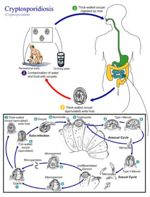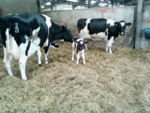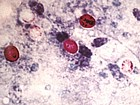Difference between revisions of "Cryptosporidium"
| (21 intermediate revisions by 3 users not shown) | |||
| Line 1: | Line 1: | ||
| − | {{ | + | {{unfinished}} |
| + | |||
{{Taxobox | {{Taxobox | ||
|kingdom =Protista | |kingdom =Protista | ||
|phylum =Myzozoa | |phylum =Myzozoa | ||
| − | |class = | + | |class =Coccidea |
|sub-class = | |sub-class = | ||
|order =Eucoccidiorida | |order =Eucoccidiorida | ||
| Line 10: | Line 11: | ||
|sub-family = | |sub-family = | ||
|genus =Cryptosporidium | |genus =Cryptosporidium | ||
| − | |species = | + | |species =many |
}} | }} | ||
==Overview== | ==Overview== | ||
| + | Cryptosporidium is the single genus in the cryptosporidiidae family and contains at least 13 recognised species. These small protozoan parasites are able to infect a wide range of hosts including mammals, birds, reptiles and fish. These species are the causative agents of [[cryptosporidiosis]], ''C. parvum'' is the most common species infecting mammals and man. | ||
| + | |||
| + | |||
| + | |||
| + | ==Recognition== | ||
[[Image:Cryptosporidium parvum.jpg|thumb|right|150px|''Cryptosporidium parvum'' - Courtesy of the Laboratory of Parasitology, University of Pennsylvania School of Veterinary Medicine]] | [[Image:Cryptosporidium parvum.jpg|thumb|right|150px|''Cryptosporidium parvum'' - Courtesy of the Laboratory of Parasitology, University of Pennsylvania School of Veterinary Medicine]] | ||
| + | [[Image:ImageNeeded.png|thumb|right|150px|''C. muris'']] | ||
[[Image:Cryptosporidium Life Cycle.jpg|thumb|right|150px|''Cryptosporidium Life Cycle'' - Alexander J. da Silva et al., WikiMedia Commons]] | [[Image:Cryptosporidium Life Cycle.jpg|thumb|right|150px|''Cryptosporidium Life Cycle'' - Alexander J. da Silva et al., WikiMedia Commons]] | ||
[[Image:Calf.jpg|thumb|right|150px|Calf - nabrown RVC]] | [[Image:Calf.jpg|thumb|right|150px|Calf - nabrown RVC]] | ||
[[Image:Cryptosporidium ruminant.jpg|thumb|right|150px|Ruminant ''Cryptosporidium'' - Joaquim Castellà Veterinary Parasitology Universitat Autònoma de Barcelona]] | [[Image:Cryptosporidium ruminant.jpg|thumb|right|150px|Ruminant ''Cryptosporidium'' - Joaquim Castellà Veterinary Parasitology Universitat Autònoma de Barcelona]] | ||
| − | |||
| − | |||
| − | |||
| − | |||
Cryptosporidium species are extremely small in size, the oocysts being 4-5μm. They parasitise the epithelial cells lining the alimentary and respiratory tracts of the host. The developmental stages of the parasite are confined to the brush border area of the gut epithelium. | Cryptosporidium species are extremely small in size, the oocysts being 4-5μm. They parasitise the epithelial cells lining the alimentary and respiratory tracts of the host. The developmental stages of the parasite are confined to the brush border area of the gut epithelium. | ||
==Life Cycle== | ==Life Cycle== | ||
| − | Cryptosporidium mostly has a standard [[Coccidia Life Cycle|coccidial life cycle]] with a few exceptions. The oocyte does not contain sporocysts, instead the | + | Cryptosporidium mostly has a standard [[Coccidia Life Cycle|coccidial life cycle]] with a few exceptions. The oocyte does not contain sporocysts, instead the sporozoites are free within the oocyst. The pre patent period of of cryptosporidium is 1 week, after which '''sporulated''' oocysts are shed in the hosts faeces. |
==Pathogenesis== | ==Pathogenesis== | ||
| − | + | *Causes outbreaks of [[Diarrhoea|diarrhoea]] in young animals | |
| − | + | *Common cause of calf-hood scours | |
| + | **Older animals may be asymptomatic carriers | ||
| + | **Contributes to [[Calf Diarrhoea, Undifferentiated Neonatal|undifferentiated neonatal calf diarrhoea]] which is a mixed viral enteritis in calves | ||
| + | |||
| + | *Common infection in AIDS patients | ||
==Epidemiology== | ==Epidemiology== | ||
| − | |||
| − | |||
| − | |||
| − | |||
| − | |||
| − | + | *Direct faecal-oral infection | |
| − | + | **E.g. School parties visiting farms | |
| − | + | ||
| − | + | *Water-borne infection | |
| − | + | **E.g. contaminated water supply may infect hundreds of people | |
| − | + | **Difficult to locate source | |
| − | + | ||
| − | [ | + | ==Diagnosis== |
| − | + | ||
| − | + | *Faecal smear | |
| − | [ | + | **Ziehl-Neelson (ZN) stain |
| − | + | **Oocysts stain red against a blue/green background | |
| − | + | ||
| − | + | *Immunoassays | |
| − | + | **Detect oocysts in faeces | |
| + | |||
| + | ==Control== | ||
| + | |||
| + | *Isolate/quarantine bought-in calves | ||
| + | **Treat if signs of [[Diarrhoea|diarrhoea]] present | ||
| + | |||
| + | *Good hygiene, adequate bedding and disinfection of calf pens is important | ||
| + | |||
| + | *Prevention/treatment | ||
| + | **Halofuginone | ||
| + | ***Halocur or Intervet | ||
| + | ***Oral dosage | ||
| + | |||
| + | |||
| + | ==Villus Atrophy in Enteritis== | ||
| + | |||
| + | * Affects calf, lamb, piglet, kitten. | ||
| + | * Increasingly important as part of the neonatal [[Diarrhoea|diarrhoea]] complex in calves. | ||
| + | * Zoonosis. | ||
| + | |||
| + | ====Pathology==== | ||
| + | |||
| + | =====Gross===== | ||
| + | |||
| + | * Intestines diffusely reddened, with fluid contents. | ||
| + | |||
| + | =====Histological===== | ||
| + | * Tiny parasites on surface of epithelium. | ||
| + | * Villus atrophy and fusion. | ||
| + | * Iinflammation (mainly lymphoid) in crypts and lamina propria. | ||
| − | + | <big>'''[[Cryptosporidia Flashcards]]</big> | |
| − | + | [[Category:Miscellaneous_Protozoa]] | |
[[Category:Enteritis,_Parasitic]] | [[Category:Enteritis,_Parasitic]] | ||
[[Category:Enteritis,_Villus_Atrophy]] | [[Category:Enteritis,_Villus_Atrophy]] | ||
| − | [[Category: | + | [[Category:To_Do_-_NickJ]] |
| + | [[Category:To_Do_-_Parasites]] | ||
[[Category:Coccidia]] | [[Category:Coccidia]] | ||
Revision as of 16:47, 26 July 2010
| This article is still under construction. |
| Cryptosporidium | |
|---|---|
| Kingdom | Protista |
| Phylum | Myzozoa |
| Class | Coccidea |
| Order | Eucoccidiorida |
| Family | Cryptosporidiidae |
| Genus | Cryptosporidium |
| Species | many |
Overview
Cryptosporidium is the single genus in the cryptosporidiidae family and contains at least 13 recognised species. These small protozoan parasites are able to infect a wide range of hosts including mammals, birds, reptiles and fish. These species are the causative agents of cryptosporidiosis, C. parvum is the most common species infecting mammals and man.
Recognition
Cryptosporidium species are extremely small in size, the oocysts being 4-5μm. They parasitise the epithelial cells lining the alimentary and respiratory tracts of the host. The developmental stages of the parasite are confined to the brush border area of the gut epithelium.
Life Cycle
Cryptosporidium mostly has a standard coccidial life cycle with a few exceptions. The oocyte does not contain sporocysts, instead the sporozoites are free within the oocyst. The pre patent period of of cryptosporidium is 1 week, after which sporulated oocysts are shed in the hosts faeces.
Pathogenesis
- Causes outbreaks of diarrhoea in young animals
- Common cause of calf-hood scours
- Older animals may be asymptomatic carriers
- Contributes to undifferentiated neonatal calf diarrhoea which is a mixed viral enteritis in calves
- Common infection in AIDS patients
Epidemiology
- Direct faecal-oral infection
- E.g. School parties visiting farms
- Water-borne infection
- E.g. contaminated water supply may infect hundreds of people
- Difficult to locate source
Diagnosis
- Faecal smear
- Ziehl-Neelson (ZN) stain
- Oocysts stain red against a blue/green background
- Immunoassays
- Detect oocysts in faeces
Control
- Isolate/quarantine bought-in calves
- Treat if signs of diarrhoea present
- Good hygiene, adequate bedding and disinfection of calf pens is important
- Prevention/treatment
- Halofuginone
- Halocur or Intervet
- Oral dosage
- Halofuginone
Villus Atrophy in Enteritis
- Affects calf, lamb, piglet, kitten.
- Increasingly important as part of the neonatal diarrhoea complex in calves.
- Zoonosis.
Pathology
Gross
- Intestines diffusely reddened, with fluid contents.
Histological
- Tiny parasites on surface of epithelium.
- Villus atrophy and fusion.
- Iinflammation (mainly lymphoid) in crypts and lamina propria.




